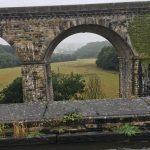We left Ellesmere as the forecast wasn’t too good, the wind was getting up and black clouds were above us. We reversed out of the Ellesmere arm into the junction area where we were going to turn to head up towards Llangollen when this boat came charging down with only one thing in his mind; he was going to moor on the junction to visit Tesco. He cut straight across our stern, forcing us to go full ahead to avoid a collision, which then left us at the mercy of the wind, blowing us onto the canal side; not where we wanted to be and it also restricted our turning space. We were not too sure if it was a hire boat, but if not, he should have known better.
We were now on our way and again the first thing was to start our brand new shiny Honda Inverter Generator and plug the washing machine straight into it, so much easier and no frustration; how to please Christine.
The Llangollen canal is probably the most popular canal on the
network, confirmed by the high number of hire boats about. There are the holidaymakers who regularly hire a canal boat and you know there won’t be any problems when you come across them, then there are the less experienced, but you can gauge what they are about to do and act accordingly, and that leaves the total “plonkers”, the ones when you see them the only thing you can do is stop, close your eyes, and hope for the best. We have often wondered if there is any training or tips given before they set off, if nothing else, how to operate the locks would be useful!!!!!
The countryside continues to wind its way towards the Welsh hills; all very pretty but slowly we noticed the change in farming, moving from cattle to sheep. The heavens opened just after lunch, most sensible
boats moored up to see it out; not us, we ploughed on and eventually stopped near Chirk Bank, where we enjoyed a pint at the last pub in England. It is the Hungarian Grand Prix this weekend, and being Saturday, we needed a TV signal for qualifying; most important.
The Llangollen canal has a checkered history, first conceived in 1791, and the grand plan was to have an inland waterway connecting the Mersey in the North, to the River Severn in the South. For numerous reasons this didn’t happen but the legacy of what was built is enjoyed today,
especially the engineering feats. Firstly we crossed the Chirk Aqueduct linking Chirk Bank (England) with Chirk (Wales) across the Ceirog Valley. This construction carries the canal through a cast iron trough, supported by 10-arches, 40-foot apart and 70-foot above the River Ceirog. Once we had traversed the aqueduct we went into the Grade II listed Chirk Tunnel, built
between 1794-1803; it is 460-yards long and it is only marginally wider than a narrow boat, and as the water flows south at 2-MPH, it was hard work making headway whilst going north. The great shame is that most people only know about the Pontcysyllte Aqueduct yet Messrs.’ Thomas Telford and William Jessop were also responsible for both the Chirk Aqueduct and Tunnel; all extraordinary feats when one considers the tools and equipment at the time; mainly manpower. Running 30 foot above and alongside the Chirk Aqueduct is a railway viaduct erected in 1846-1848 (though rebuilt in 1858) for the Shrewsbury and Chester Railway and the line is still very much in




